Excerpts from Jim Conrad's
Naturalist Newsletter
from the September 21, 2007 Newsletter issued from Sierra Gorda Biosphere Reserve, QUERÉTARO, MÉXICO
SMOOTH MESQUITES
I'm an old hand at escaping the desert's midday sun beneath frilly-leafed mesquite trees. Sunday, after reading awhile, I leaned back and saw what's shown below:
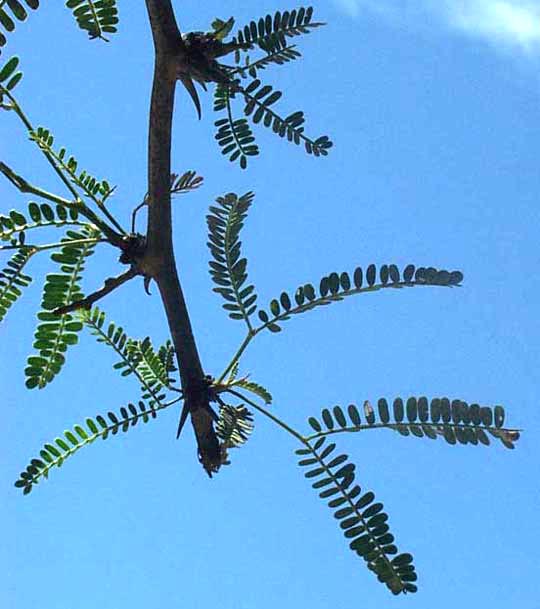
Those are mesquite leaves on a spiny, burro-chewed branch. Note the leave's curious configuration. Each leaf is doubly compound, the first division creating two featherlike leaflets atop the petiole, and then each of those leaflets is divided into numerous sub- leaflets, or pinnules. The Y-shaped form with frilly Y-arms is very unusual among tree leaves.
Something about this mesquite tree seemed different from others I've known farther north and farther south. It turns out that our Queretaro mesquites are PROSOPIS LAEVIGATA, sometimes known as Smooth Mesquites. The species so abundant in the US arid Southwest as well as in the Yucatan and southern Mexico is Prosopis juliflora, which has larger, longer leaves. Our P. laevigata seems to be a central-Mexican endemic.
Mesquite, like the abundant and useful Sweet Acacia or Huisache around Jalpan, often is treated as a trash tree. That's a shame because all mesquites are wonderful, not only for the delicious shade they offer at midday. First, they're members of the Bean Family so their roots bear fungus-inhabited nodules (mycorrhiza) that enrich the soil with nitrogen.
Also, mesquite legumes can be dried, ground and used as nutritious flour. A study analyzing mesquite-legume flour found that the "Functional characteristics of whole mesquite pod flour were similar to those of bean flour (Phaseolus vulgaris), and superior to those of whole wheat flour (Triticum sp)." An abstract of that study can be reviewed online here.
But mesquite provides great firewood. You can't beat it for the kind of ranchero-style barbecuing done around here. People here keep hacking at them, and they're slowly disappearing.
entry dated March 22, 2022, issued from near Tequisquiapan, elevation about 1,900m (6200 ft), N20.565°, W99.890°, Querétaro state, MÉXICO
MESQUITES FLOWERING
Now as the dry season begins to bite, Mesquites are much appreciated for their shade and greenness in a parched, brown/gray landscape. Mesquites here are different in general form from the Honey Mesquites we had in Texas. Our Smooth Mesquites are flowering, shown below:
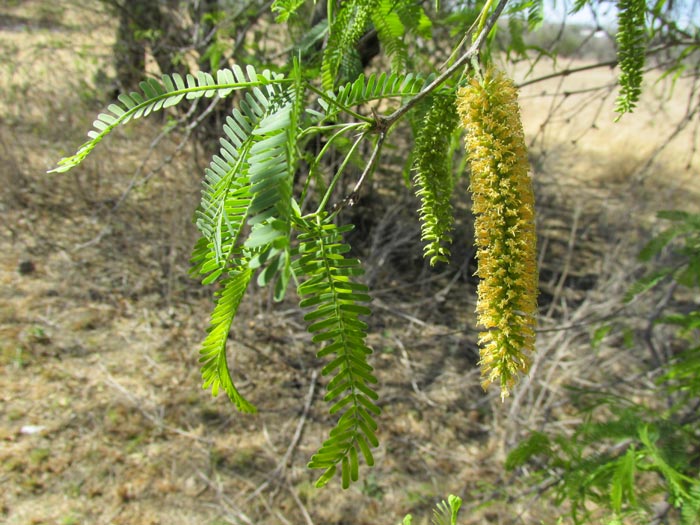
The flowers are similar, shown below:
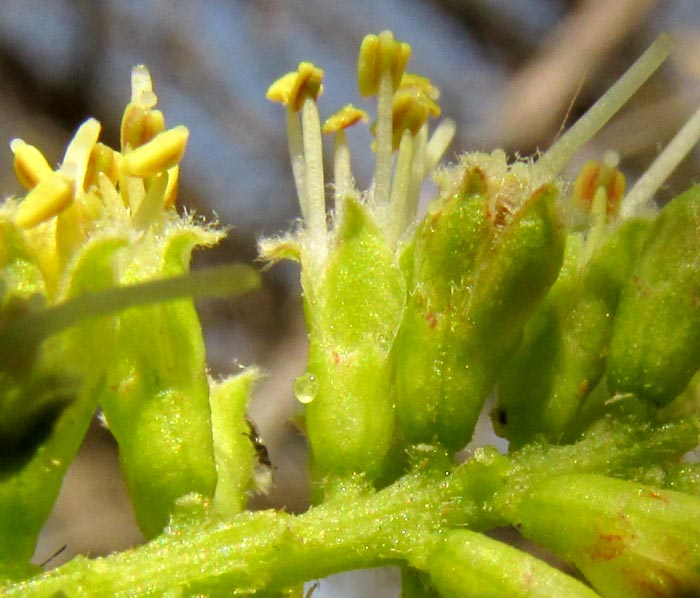
entry dated March 30, 2023, issued from near Tequisquiapan, elevation about 1,900m (6200 ft), N20.565°, W99.890°, Querétaro state, MÉXICO
(~N20.55°, ~W99.89°)
MESQUITES ISSUING LEGUMES
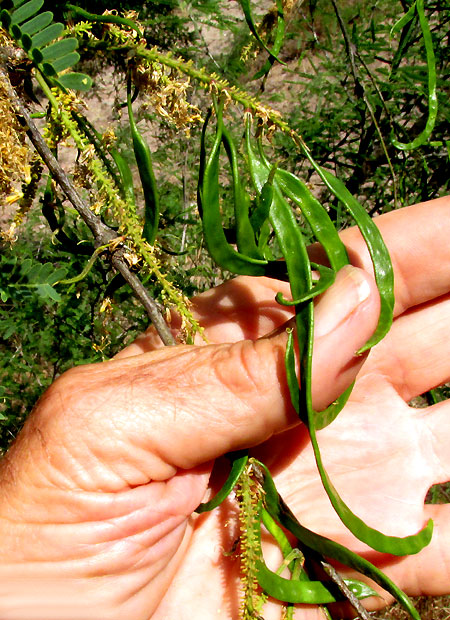
Shiny new legumes are emerging from the mesquite's spikelike racemes. Mature legumes have long provided an important food for people and livestock, but I can't find mention of these tender pods being used as food. In the above picture, note that the vast majority of flowers fall off without producing fruits. In fact, from what I see, most entire racemes fall off without any flower on them producing fruits -- just lots of pollen. Some racemes produce only one or two legumes, while others make several, like the one above.
entry dated July 13, 2022, issued from near Tequisquiapan, elevation about 1,900m (6200 ft), N20.565°, W99.890°, Querétaro state, MÉXICO
MESQUITE LEGUMES
Nowadays the mesquites are loaded with legumes, shown below:
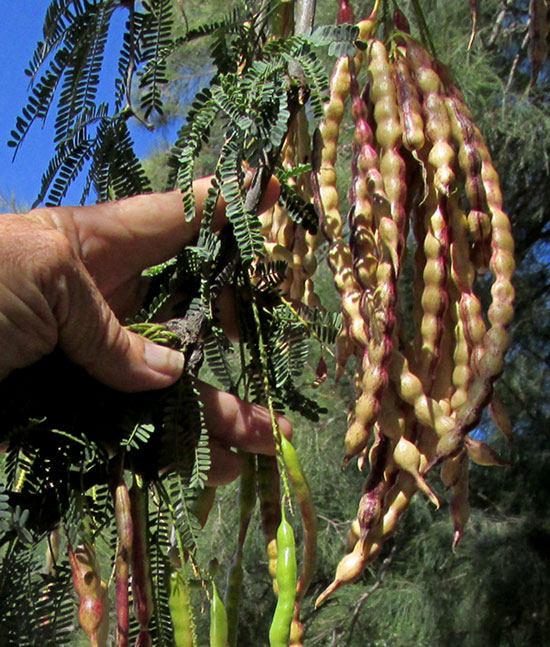
They look like greenbean pods, but they're hard. If you bend them to get at the bean, the pods snap. To expose the small, hard bean you must scrape away the pod's brittle covering and dry, somewhat gummy pulp, which doesn't separate from the bean. The pulp is a little sweet, like that of a Honeylocust's pods, but there's little of it and not as sweet. When the pods are ground to make flour, they must be drier and crispier than the ones shown in the picture. As the pods dry out, they lose their colors.
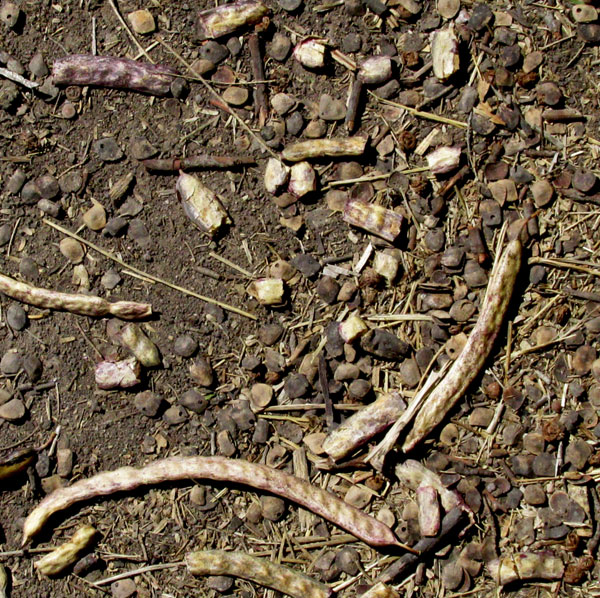
The numbers of pods dropping from trees is prodigious and the ground beneath a tree shown above tells the story of animals breaking up the pods, apparently for the sweetish pulp. They don't seem to bother with the very hard seeds, except for the worms who leave holes in some of the segments. Earlier in the year before the beans developed and the pods were somewhat softer, the broad hills of harvester ants often were littered with squared sections of mesquite pods but I never saw ants carrying sections underground.
Whoever eats the pods, the pure amount of nutrient-rich biomass being dropped on the ground nowadays by mesquites is so great that it must be an important contribution to the ecosystem. In ancient times, during this season lots of time must have been spent by people gathering and preparing mesquite pods for storing as food.
entry dated March 24, 2023, issued from near Tequisquiapan, elevation about 1,900m (6200 ft), N20.565°, W99.890°, Querétaro state, MÉXICO
MONARCH MIGRATION IN UPLAND CENTRAL MEXICO

After a winter of three or four frosts, the Monarchs have been appearing in this area for several days. Mostly they're seen among thickets of Smooth Mesquites, apparently taking nectar from the flowers. The mesquites are at their peak of flowering now. Typically only one or two occur in a tree, sometimes five or more. You don't see them here either during the cool dry season, the northern winter, or the warm rainy season, just during migrations. At certain times you can see them suddenly leave the mesquites and climb into the sky, so high and far away that they're lost to sight.
Mesquites are common, in some place abundant, from central Mexico all the way north to the US border. Thus must be important during Monarch migration, which coincides with the mesquites' flowering period.
Entry dated February 24, 2024, issued from near Tequisquiapan; elevation about 1,900m, (6200 ft), ~N20.57°, ~W99.89°; Querétaro state, MÉXICO
MESQUITE CULTURAL USES
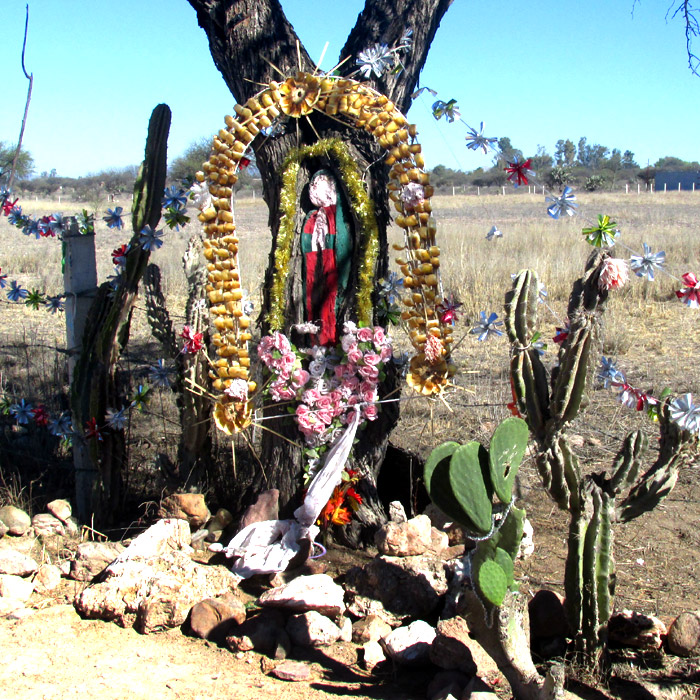
A couple of years ago, beside a dirt road outside a little village, on the trunk scar left when a large limb of a Smooth Mesquite had been torn off, someone painted a rough semblance of the Virgin of Guadalupe. At first, only a rose flower was left below the image but, the next time I passed by, someone had left a bouquet of plastic flowers. Then one day lighted candles appeared, and there were more plastic flowers. Gradually the little shrine has come to appear as seen above, and always there's a little more than was seen the last time.
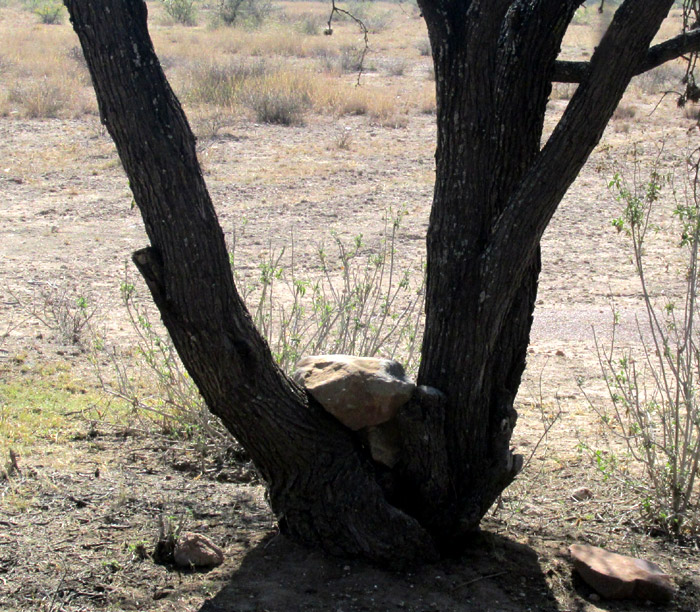
Not far away, the above rock seat was made in the fork of a mesquite trunk. In this whole area it's hard to find a single such low-forked trunk not made into a rock seat. Numerous flocks of sheep shift about grazing, and the shepherds need someplace to sit while the sheep feed. Of all tree species here, Smooth Mesquite is by far the most likely to develop forked trunks just right for such rock seats.